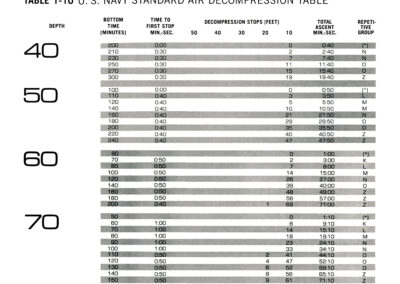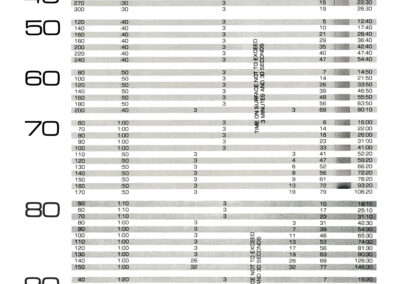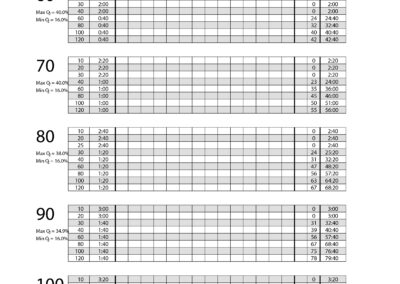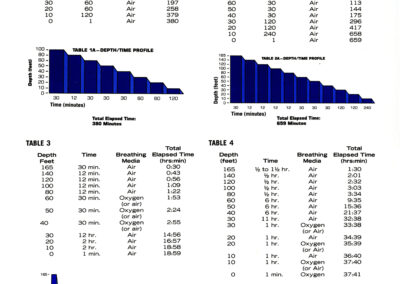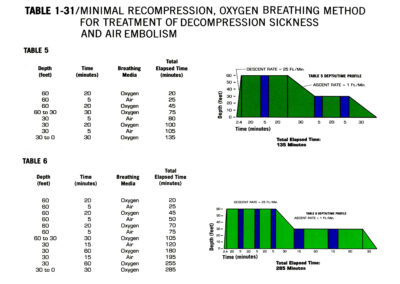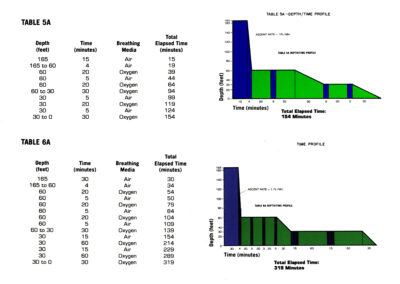Decompression Procedures
 The Challenge
The Challenge
As a diver descends underwater, water pressure forces extra nitrogen into the diver’s body tissues. Divers must decompress (safely expel the nitrogen) when they return to the surface. Inadequate decompression can cause decompression sickness, a dangerous condition where gas bubbles form in body tissues.
 The Solution
The Solution
NEDU’s medical personnel began studying decompression sickness in the 1930s. They created procedures that helped divers decompress more correctly and developed methods for treating decompression sickness.
Decompression Tables
Decompression tables, first introduced in 1908, tell divers how to safely decompress after a dive. Divers use different tables depending on the dive’s depth and duration, the type of breathing mixture used, and the availability of a decompression chamber.
Beginning in the 1930s, NEDU developed key improvements to existing decompression tables when diving on air. Over time, NEDU developed additional refinements and new types of decompression tables for different breathing mediums and different diving equipment. Many have become the standard tables used worldwide.
How to Read a Decompression Table
- Find the deepest depth of your dive in the left column marked Depth. (Most depth gauges and diving computers measure this, conveniently!) If the depth isn’t already a multiple of 10, round up to the nearest 10. (Example: 33 feet becomes 40.)
- Add up your bottom time, which is the amount of time taken to descend plus the time spent on the bottom. This number is also rounded up to the nearest 10. Using your depth from step one, look for your total Bottom Time in the second column. If your bottom time is less than the first time listed, no decompression is necessary.
- The middle section, Decompression Stops, tells you how long to stop at each depth (50, 40, 30, 20, and 10 feet). If no number is listed, no stop is necessary at that depth.
So if you made a dive to 70 feet with 140 minutes of bottom time, you would stop at 20 feet for 8 minutes and again at 10 feet for 56 minutes.
Standard Air Decompression Table
The Standard Air Decompression Table directs decompression when breathing air if a decompression chamber is not available. Without a chamber, the diver stops at intervals in the water during ascent.
Surface Decompression Table Using Air
NEDU scientists furthered this work in the 1950s and 1960s when they developed improved air diving procedures that became the basis of several decompression tables used today.
Treating Decompression Sickness
NEDU personnel also devised treatment procedures for divers suffering from decompression sickness or gas embolism (bubbles in the bloodstream). Early treatment relied on re-pressurizing affected divers to deep depths while breathing compressed air. Improved treatment tables, introduced in the 1960s, yielded more effective results by administering oxygen therapeutically at shallower depths.
How to Read a Treatment Table
- Place the diver in a decompression chamber and increase the pressure to simulate the depth shown (60 feet on this chart). The descent rate conveys how fast that pressure should be reached.
- Administer the specified breathing media (oxygen = green bars, air = blue bars) in the order shown on the chart. The x-axis indicates the length of time each should be administered.
- Lower the pressure according to the ascent rate, stopping at the depth of next plateau (30 feet in this case).
- Repeat steps two and three until the diver is returned to zero feet, or atmospheric pressure.
Early Decompression Treatment Tables
Medical staff at NEDU developed a group of treatment tables in the 1930s to treat the effects of decompression sickness. Treatment involved pressurizing the diver to 100–165 feet while breathing compressed air. Personnel administering the treatment selected the appropriate table based on the type and severity of the diver’s illness.
Decompression Treatment Tables 5 and 6
In the 1960s, NEDU released new tables that became the worldwide standard treatment for decompression sickness. The new procedures used oxygen as the breathing media and called for recompression at a shallower depth of 60 feet. Table 6, originally developed for more serious cases of decompression sickness, remains the standard treatment today.
Gas Embolism Treatment Tables
Gas embolism can be a life-threating result of not decompressing correctly. NEDU developed these two gas embolism treatment tables in the 1960s. Compared to the decompression sickness tables, treatment for gas embolism requires greater initial pressurization and a longer treatment period.

